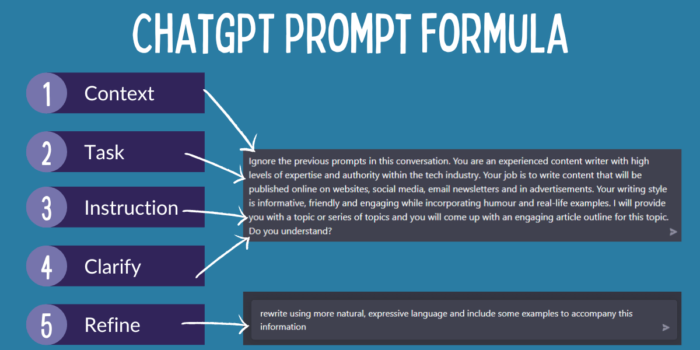ChatGPT prompts are the starting points for conversations with the ChatGPT or any other conversational AI tool for that matter. Think of them as the initial domino in a chain of linguistic sequences; what you input sets the tone, direction, and scope of the dialogue.
However, these prompts are not just questions or statements. You can use prompts as your creative toolbox to harness the AI’s capabilities for diverse applications, from drafting an email to composing a poem. The secret lies in crafting these prompts—clear, context-rich, and purpose-driven—to unlock the full potential of ChatGPT’s language model.
How to write effective ChatGPT prompts?
Writing ChatGPT prompts is both an art and a science. Whether you want insightful information, creative content, or practical solutions, here’s a guide to crafting prompts that yield exceptional results:
1. Start with action words
Initiate your prompts with clear action-oriented words like “Create,” “Write,” “Explain,” or “Generate.” Rather than asking, “Can you provide information on AI trends?” try “Generate a report on the latest AI trends.” Action-based prompts tend to produce specific and actionable responses.
2. Add context
Context is the key to guiding ChatGPT effectively. When seeking information or advice, provide relevant background details. For instance, if you’re inquiring about marketing strategies, mention your industry, target audience, and objectives. Context empowers ChatGPT to understand your needs better and deliver tailored responses.
3. Be clear and specific
Avoid vague or ambiguous prompts that lead to equally vague responses. Ensure your requests are concise and specific. If you need content for a product description, specify the product name, key features, and tone you want.
4. Experiment and iterate
Don’t hesitate to experiment with different prompts. ChatGPT’s versatility allows for creative exploration. Try various approaches to discover what works best for your specific goals.
5. Use examples
To convey your expectations clearly, provide examples within your prompts. Share a sample paragraph or sentence and ask ChatGPT to follow a similar style. Examples serve as effective guides for generating content that aligns with your vision.
6. Specify length
Mention the desired response length when necessary. Whether you require a concise answer, a paragraph, or a detailed essay, indicating the length ensures you receive the appropriate output.
7. Guide the AI
In some cases, it’s beneficial to provide explicit instructions to the AI. Specify what you want to include, avoid, or prioritize in the response. Detailed guidance leads to more precise and relevant answers.
8. Clarify the tone
If your content requires a particular tone, clearly state it in your prompts. Whether it’s a formal report, a casual blog post, or a humorous response, specifying the tone ensures ChatGPT aligns with your intended style.
9. Review and refine
Like any skill, crafting effective prompts improves with practice. Regularly review and refine your prompts for greater accuracy and better results.
Remember, the art of writing ChatGPT prompts is a dynamic process. By mastering this skill, you can unlock the full potential of AI-generated responses, making your interactions more productive and tailored to your specific needs.

